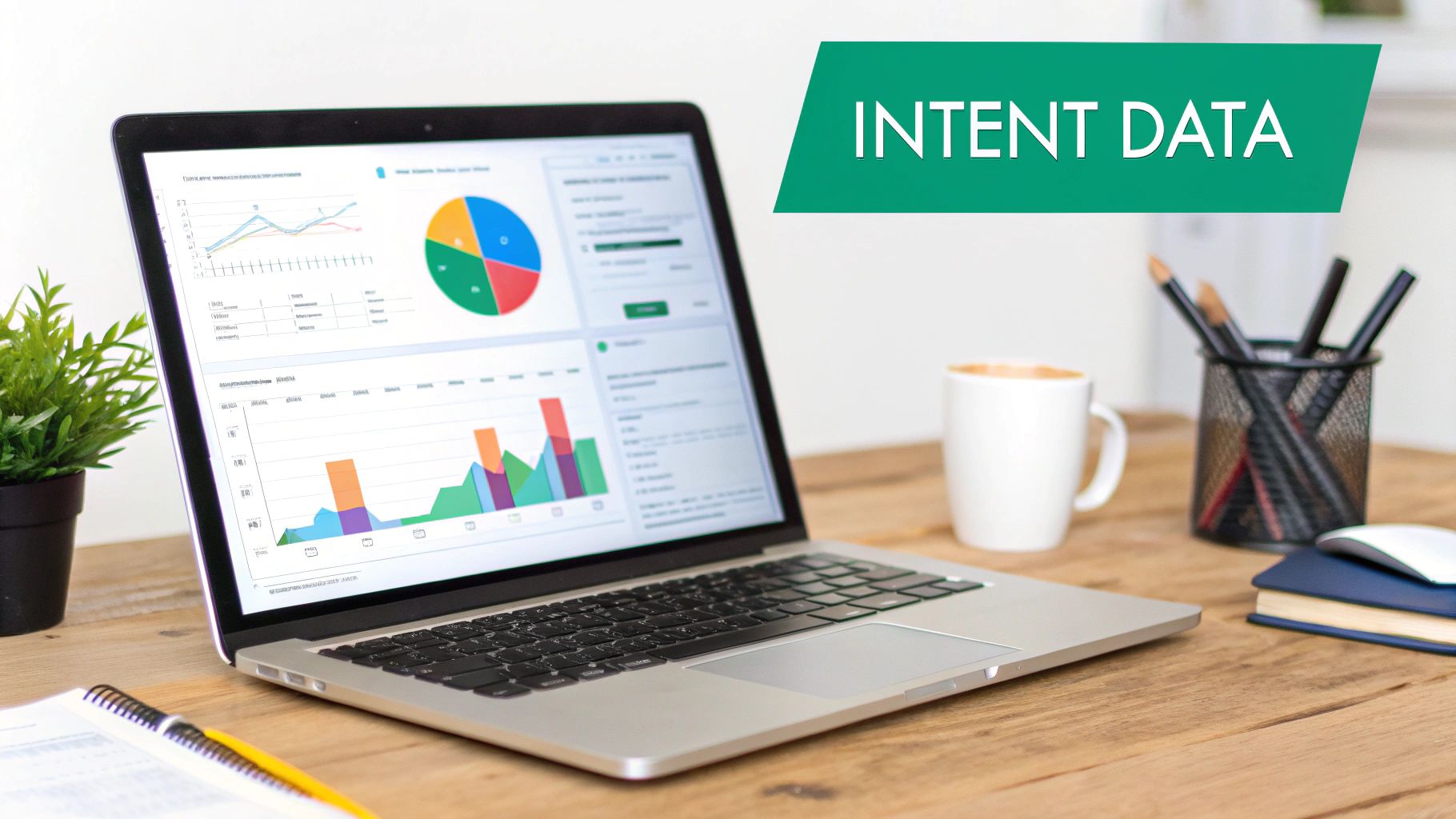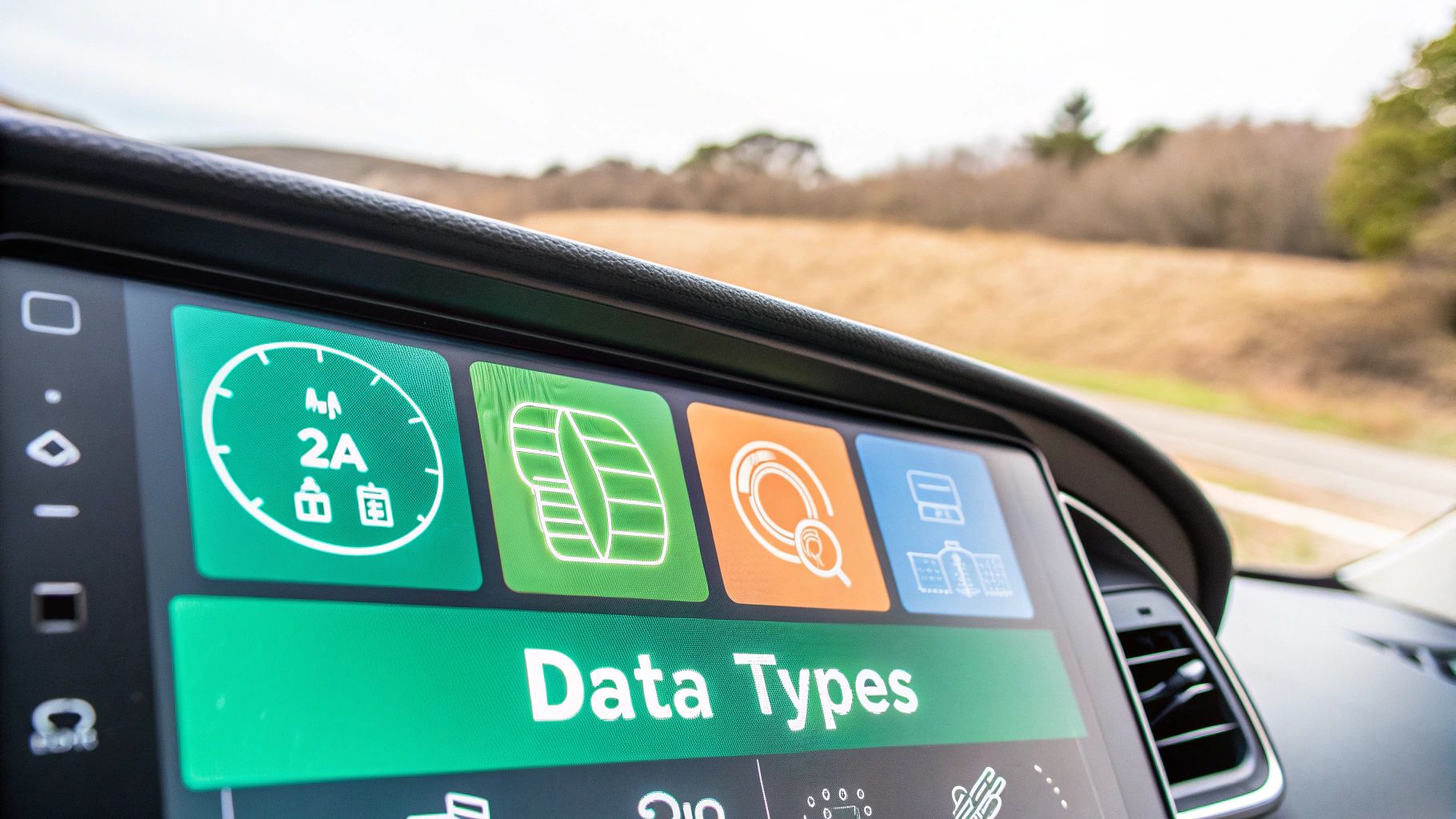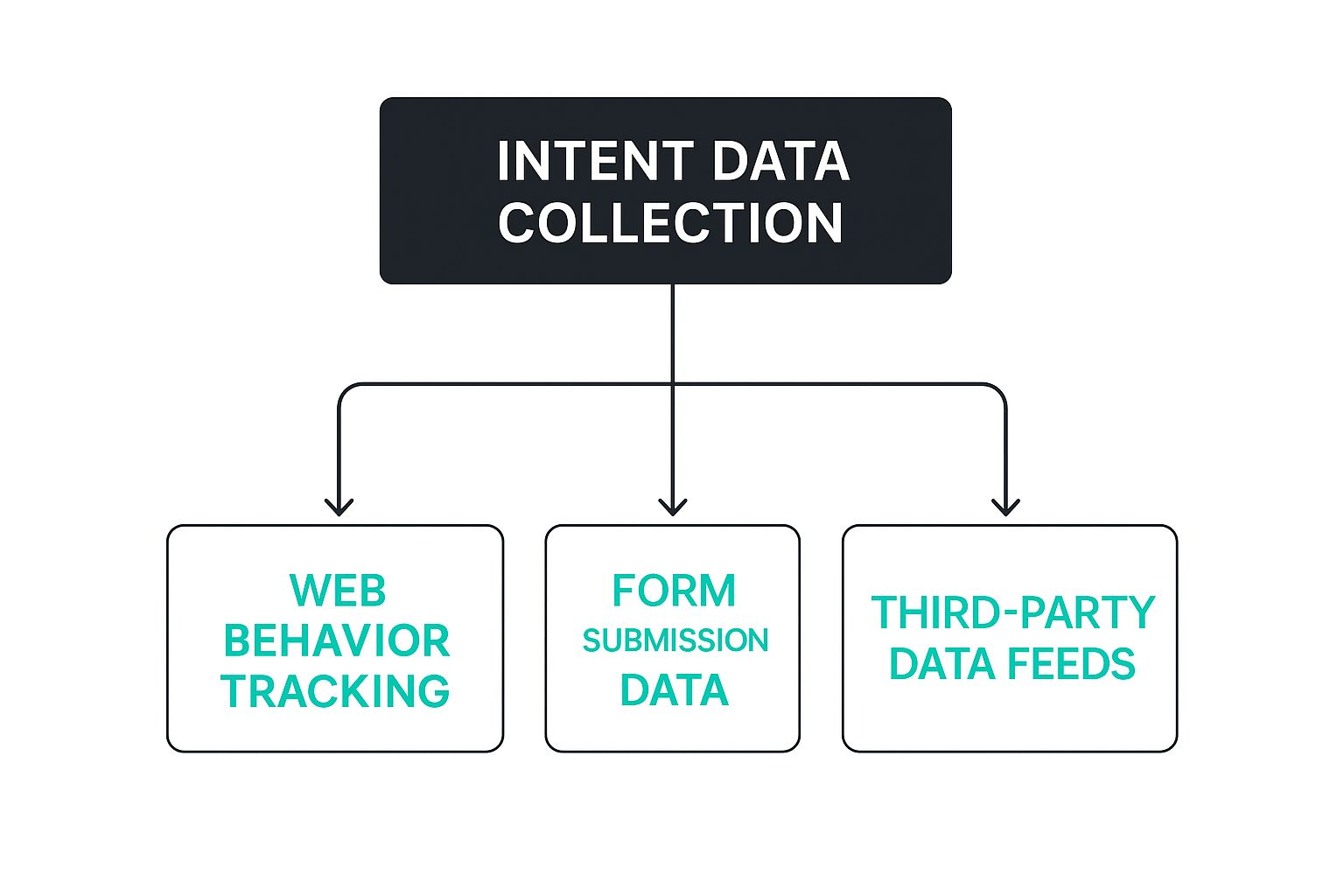What Is Intent Data and How Does It Work?
So, what exactly is intent data?
Think of it as the digital body language of a potential customer. It's the collection of all those little behavioral signals that show a person or an entire company is actively researching a product or service like yours. These clues let you know who's interested before they ever fill out a form, giving your team the chance to engage them at the perfect moment.
Understanding the Digital Breadcrumbs of Intent Data

Imagine your ideal customer is out there on the web, leaving a trail of digital breadcrumbs with every click, download, and search they make. They might be reading articles about a specific problem you solve, checking out your competitors' websites, or interacting with certain topics on social media. Each action is a signal—a piece of a much bigger puzzle.
Intent data is the art and science of gathering and making sense of these signals to understand where a buyer is in their journey.
This information gives you a massive advantage by flipping your strategy from reactive to proactive. Instead of just waiting around for someone to raise their hand by filling out a contact form, you can spot their interest while they’re still in the research phase. That early insight is pure gold for both sales and marketing teams.
From Anonymous Signals to Actionable Insights
The real magic happens when you can connect all that anonymous online activity to a specific company that’s actively in-market for your solution. It’s no longer just random noise; it becomes a clear sign that a particular account is showing a spike in interest. This lets you focus your resources and craft outreach that actually lands.
Here’s where it really makes a difference:
- Early Identification: Spot potential buyers right at the start of their journey.
- Smarter Personalization: Tailor your messages and content based on the actual topics they're researching.
- Sales Prioritization: Help your sales team focus on the accounts most likely to convert, which helps shorten sales cycles.
- Competitive Advantage: Get a heads-up when prospects are looking at your competitors.
By understanding a prospect's digital behavior, you're no longer guessing who to talk to. You're following a clear map that leads directly to your next customer, allowing you to start conversations that are both timely and relevant.
And this isn't some niche strategy; it's rapidly becoming the standard. The global B2B Buyer Intent Data Tools market was valued at around USD 1.2 billion in 2023 and is expected to hit about USD 4.8 billion by 2032.
That explosive growth points to a huge shift toward using data to understand what customers are doing and to personalize marketing. You can dig deeper into these market trends and what they mean for B2B companies in this detailed report. This kind of approach sets the stage for a much smarter and more efficient way to go to market.
Intent Data vs Traditional Lead Data
To really get why this is such a game-changer, it helps to see how intent data stacks up against the old way of doing things. Traditional lead data is often reactive—you only get information after someone has filled out a form. Intent data is proactive, giving you a look into their needs much earlier.
Here's a quick comparison:
| Attribute | Intent Data | Traditional Lead Data |
|---|---|---|
| Timing | Proactive (early research phase) | Reactive (form-fill or direct contact) |
| Source | Behavioral signals (clicks, downloads) | Explicit information (contact forms) |
| Nature | Implicit interest | Explicit interest |
| Focus | Identifying potential buyers | Capturing known leads |
| Advantage | Get ahead of the competition | Reliable but often late to the game |
Ultimately, while traditional leads tell you who was interested, intent data tells you who is interested right now. That shift in timing makes all the difference in a competitive market.
How Intent Data Is Collected and Processed

Knowing what intent data is gets you halfway there. The real magic happens when you understand how it’s captured and turned into something your sales team can actually use.
Think of it like a detective piecing together a case. One clue might not mean much, but a collection of clues from different scenes starts to tell a compelling story. That's exactly how intent data works—it pulls together small signals from all over to build a clear picture of a buyer's interest.
These signals typically come from three main sources. By blending the insights from each one, you get a much more complete and reliable view of which companies are genuinely looking for a solution like yours.
The Core Sources of Intent Data
The most powerful data usually starts right at home. This is your first-party intent data, and it’s the information you gather directly from your own website, blog, or CRM.
Think about actions like someone downloading a whitepaper, spending five minutes on your pricing page, or coming back to read about a specific product feature. Because you own this data, it's incredibly accurate. It gives you a direct window into how prospects are engaging with your brand.
Next up is second-party data. This is basically someone else’s first-party data that you get through a partnership. Maybe you co-hosted a webinar with another company in your space or sponsored an article on an industry news site. The data from those activities gives you a peek at an audience that’s interested in relevant topics but might not know about you yet.
Finally, there's third-party intent data. This is collected by specialized data companies that track online behavior across millions of websites. They monitor what topics and keywords companies are researching, giving you a broad, market-level view of buying signals. This data is fantastic for finding "net-new" accounts that are showing interest in your category but haven't landed on your site.
By layering these data types, you move from a narrow view to a panoramic one. First-party data tells you who is interested in you, while third-party data reveals who is interested in your industry—a powerful combination for any GTM team.
From Raw Signals to Actionable Insights
Just collecting all this data isn't enough. A page view here and a download there are just raw signals. They need to be processed and analyzed before they become meaningful. This is where technology steps in.
Modern platforms use algorithms to connect these individual actions, link them back to a specific company, and score how intense the interest really is.
A single signal might not mean much on its own, but a cluster of them definitely does. For example, if several people from the same company start researching keywords related to your product and visiting competitor review sites all in the same week, that's a huge buying signal. To catch these patterns, it's worth looking into the top user behavior analytics tools available.
This processing stage is what transforms a flood of noisy data into a clean, prioritized list of accounts your sales team can reach out to with confidence.
Breaking Down the Different Types of Intent Data
Not all buying signals are created equal. Understanding the different kinds of intent data is a bit like learning to read a prospect's digital body language—some signals are just subtle hints, while others are basically a flashing neon sign that says "I'm ready to talk."
Learning to spot these differences is how you tailor your outreach for the biggest impact.
Contextual Intent: The Early Research Phase
The journey usually starts with contextual intent. This is the broadest signal you'll see, where a prospect is just researching a general topic or problem. They aren't looking for a specific solution just yet.
Think of someone reading articles like "how to improve team productivity" or browsing forums about "common B2B marketing challenges." They're in the early awareness stage, still figuring out the right questions to ask. This kind of intent shows a general curiosity, but it's a top-of-funnel signal that helps you spot potential future customers long before they even know they need you.
Keyword Intent: From Broad Topics to Specific Solutions
As a prospect gets more serious, their behavior shifts to keyword intent. This is a much stronger signal. It tells you they've moved past general reading and are now actively looking for answers.
Instead of browsing broad topics, they’re plugging specific search queries into Google, like "best CRM for small businesses" or "top AI content tools." These targeted searches show a real need and a much more defined interest. It’s the difference between wandering through the business section of a library and asking the librarian for a specific book on sales automation.
This image gives you a simple breakdown of how this data comes together.

As you can see, companies collect these signals from direct web behavior, explicit actions like filling out a form, and broader third-party data feeds. This creates a complete picture of a prospect's journey.
Engagement Intent: The Strongest Signal of All
Finally, we get to the most powerful signal of all: engagement intent. This is the data you get when a prospect directly interacts with your brand. It's a first-party signal, meaning it comes straight from your own website and digital properties.
Engagement intent is the digital equivalent of a prospect walking into your store. They've moved from browsing online to actively considering you as a potential partner.
These high-value actions are undeniable proof of interest. They're the green light for your sales team to reach out immediately.
- Downloading a Case Study: This shows they want to see proof that you can deliver results.
- Visiting Your Pricing Page: This is a clear sign they're evaluating budget and are likely in the decision stage.
- Requesting a Demo: This is the ultimate buying signal—they are ready to have a sales conversation.
Different intent signals tell you where a prospect is in their buying journey. The table below breaks down how to interpret these signals and what actions you might take.
Levels of Buyer Intent Signals
This table categorizes different intent signals from low to high, helping you prioritize leads based on signal strength.
| Intent Level | Example Signal | Potential Action |
|---|---|---|
| Low | Reading a blog post on a general industry topic. | Add them to a top-of-funnel nurturing sequence with related content. |
| Medium | Searching for "best software for [your category]." | Target them with ads showcasing your product's key features. |
| High | Visiting your pricing page multiple times in a week. | Trigger an alert for a sales rep to initiate personalized outreach. |
| Very High | Requesting a product demo or starting a free trial. | Sales team should follow up within hours to schedule a conversation. |
By separating low-intent browsers from high-intent buyers, you can focus your resources where they'll make the most difference.
By distinguishing between contextual, keyword, and engagement intent, you can meet potential customers with the right information at the exact moment they need it. This dramatically improves your chances of turning a curious browser into a happy customer.
Putting Intent Data Into Action

Alright, you get the theory behind intent data. That’s the first step. But the real magic happens when you turn those insights into actual business results.
This is where sales and marketing teams can finally stop guessing and start using data-driven strategies that make a real difference. Intent data closes the gap between knowing who might be a good fit and knowing when and how to actually reach out to them.
The applications are pretty diverse, but they all circle back to one core idea: making every single interaction more relevant, timely, and effective.
Hyper-Personalized Ad Targeting
One of the most immediate ways to use intent data is to sharpen your ad campaigns. Forget casting a wide net with generic ads. Instead, you can pour your ad spend directly onto accounts that are actively researching solutions like yours.
This kind of precision means your budget isn't wasted. You're hitting prospects who are already in a research mindset, making every dollar count.
Imagine your team gets an alert: a key target account is digging into content about your biggest competitor. Boom. You can instantly serve them digital ads with a targeted comparison guide or a case study showing exactly why you’re the better choice. It's a timely move that can sway their decision long before they ever talk to a salesperson.
Optimizing Content Strategy
Intent data is also a goldmine for anyone creating content. By seeing what topics and keywords your ideal customers are searching for, you can spot content gaps and build resources that speak directly to their problems.
This isn't just about creating content for the sake of it. It’s about producing genuinely helpful stuff that pulls in high-quality traffic and establishes your brand as the one with the answers.
For instance, if you see a spike in searches around "automating B2B workflows," you can quickly spin up a blog post, webinar, or guide on that very topic. This not only attracts the right prospects but also fuels your entire B2B lead generation engine with content people are actually looking for. It's a cornerstone concept we dive into deeper in our beginner's guide to B2B lead generation.
Timely and Relevant Sales Outreach
This is where intent data really shines. It gives your sales team the ultimate conversation starter, turning cold, generic outreach into warm, relevant engagement. When an SDR knows an account is actively looking for a solution, their call or email immediately becomes more helpful and welcome.
Intent data transforms a sales call from, "Are you interested in our solution?" to "I saw your company is exploring ways to solve [problem], and I have a few ideas that could help." That shift makes a world of difference in getting a meeting booked.
This isn't just a nice-to-have anymore; it's becoming a core part of modern go-to-market strategies. A recent survey found that 67% of B2B companies now use intent data for their digital advertising, and 57% use it for lead generation.
But there’s a catch. The same report shows that 70% of users point to data quality as a major hurdle. It highlights just how critical it is to choose the right provider for your information.
How AI Is Supercharging Intent Data
Think of intent data as the map to your next customer. It shows you the roads they're taking and the places they're stopping. But AI? That's the high-powered engine that reads the map, calculates the best route, and gets you there at lightning speed.
The sheer volume of raw behavioral signals out there is overwhelming for any human team. It's just too much noise. This is where AI completely changes the game. It sifts through billions of those tiny data points to find the meaningful patterns—the whispers of intent that humans would almost certainly miss.
An AI algorithm is like a tireless analyst who never sleeps, never takes a coffee break. It can spot a stray blog visit from a company, connect it to a competitor keyword search they made last week, and tie it to a recent spike in their social media activity. Instantly, it flags this combination as a powerful buying signal. This isn't just about moving faster; it's about uncovering insights that are deeper and far more predictive.
Unlocking Predictive Power
The real magic of AI is its ability to shift from just seeing what people are doing now to predicting what they'll do next. By chewing on historical data, AI models learn what a typical buyer's journey looks like for your business. More importantly, they can flag accounts that are just starting to show those early, subtle signs of interest.
This gives your team a massive head start. Instead of just reacting to the loud, obvious signals, you can proactively engage accounts that are most likely to enter a buying cycle soon. You get to start the conversation before your competitors even know there's a conversation to be had.
AI transforms intent data from a rearview mirror showing past actions into a crystal ball offering a glimpse into future purchasing decisions. It helps you focus not just on who is in-market today, but who will be in-market tomorrow.
From Automation to Personalization at Scale
AI’s role doesn't stop at analysis; it’s absolutely critical for putting that data to work. It automates the tedious, manual processes that used to eat up so much time, which in turn makes it possible to personalize your outreach on a massive scale.
- AI-Driven Lead Scoring: Forget static scoring models. Algorithms can dynamically score leads based on the intensity and recency of their intent signals, making sure your sales reps are always focused on the absolute hottest prospects.
- Automated Content Personalization: AI can tailor website content, emails, and ads on the fly based on a visitor's detected interests, creating a much more relevant and engaging experience.
- Trend Identification: By analyzing data across the entire market, AI can spot emerging topics and trends, giving your content and product teams invaluable strategic direction.
This combination of AI and intent data is a proven formula. Companies using AI for segmentation report 26% better ad targeting and an impressive 32% higher conversions. It’s easy to see why 88% of marketers now use AI in their daily work, with many using it to get ahead.
When you bring AI into the picture, your business can simply make better decisions, faster. You can deliver the right message at exactly the right time. To get a deeper look at how this all works together, check out our complete guide to AI lead generation tools, which explores how these technologies drive real growth.
Choosing the Right Intent Data Provider
Picking the right intent data partner is a big deal. The quality of the insights you get will make or break your go-to-market strategy. With so many vendors out there, it’s easy to get lost in flashy sales pitches, but the key is to focus on what actually delivers a return.
Your evaluation really needs to boil down to a few core things. Not every provider is upfront about where their data comes from, so you have to ask the tough questions. A good partner should have no problem explaining exactly how they collect their data.
Key Evaluation Criteria
When you’re comparing different platforms, keep these factors at the top of your mind. They’ll help you tell the difference between a tool that delivers real signals and one that just creates a lot of noise.
Data Source Transparency: Where is this data actually coming from? Is it a private co-op, messy bidstream data, or their own publisher network? Knowing the source helps you figure out how reliable and relevant it will be for your business.
Data Accuracy: How fresh is the information? Ask about their data verification process and how often signals are updated. Stale data just leads to wasted time and missed shots.
Integration Capabilities: A powerful tool is pretty useless if it doesn’t play nice with your current tech stack. Make sure the platform plugs right into your CRM, marketing automation system, and the other tools your team lives in every day.
The goal here is to find a provider whose data doesn't just tell you who is showing interest, but also gives you the context your team needs to act on it. The right data helps your team send outreach that’s both perfectly timed and super relevant.
Ultimately, you have to do your homework to make a smart choice. As you figure out which solution is the best fit, it’s worth researching the best intent data providers on the market to see how different platforms measure up on these key points. Finding a partner that lines up with your specific goals is the most important step in turning intent data into a real revenue engine.
Frequently Asked Questions About Intent Data
Even after getting a handle on what intent data is, some practical questions always seem to pop up. Let's walk through some of the most common ones so you can feel confident about how it all works and how you can use it.
Is Intent Data GDPR and CCPA Compliant?
Yes, any reputable intent data provider is fully compliant with major privacy regulations like GDPR and CCPA. The data collection is all about company-level behavior, not sensitive personal information.
The signals are usually aggregated or anonymized, tracking a company's research interests, not what a specific individual is browsing in private. Still, it's always a good idea to double-check a provider's specific compliance policies before you sign anything.
How Is Intent Data Different From Predictive Analytics?
It's helpful to think of it like this: intent data is the raw ingredient, while predictive analytics is the finished recipe.
Intent data tells you what is happening right now—which companies are actively researching specific topics. Predictive analytics uses AI to analyze that data, along with historical trends, to forecast what is likely to happen next.
One gives you the "what," and the other gives you the "so what." Together, they help you get ahead of future buying cycles instead of just reacting to them.
How Quickly Can I See Results From Using Intent Data?
The timeline always varies a bit, but most teams start seeing some early wins within the first quarter. These first benefits usually show up as more effective ad targeting and way higher engagement rates on outreach.
For a closer look at this, our article on why cold outreach doesn't work anymore explains how using intent makes your messages feel relevant and gets much better responses.
The full impact on your bottom line—like shorter sales cycles and a real bump in revenue—usually becomes clear after about six to twelve months. That's when your team has had time to really dial in the strategy and make the data a part of their everyday routine.
Ready to stop guessing and start engaging with buyers who are actively looking for your solution? Intently uses AI to find high-intent conversations on social platforms and delivers qualified leads directly to you. Discover your next customer with Intently.ai.
